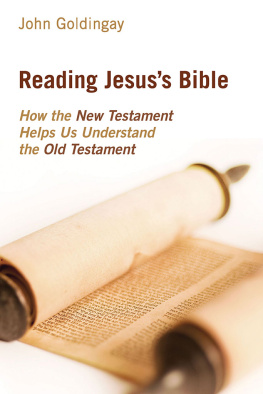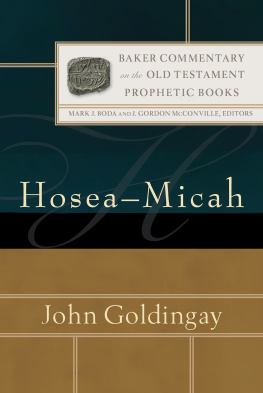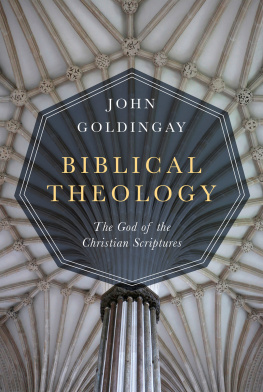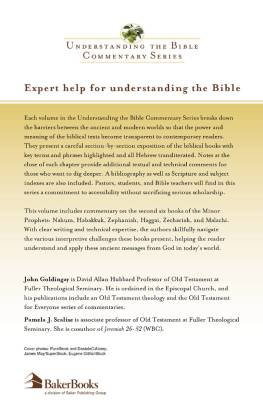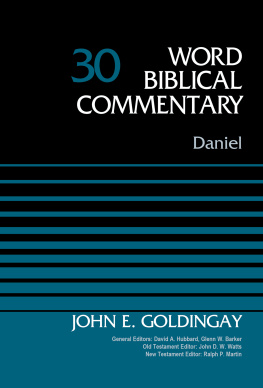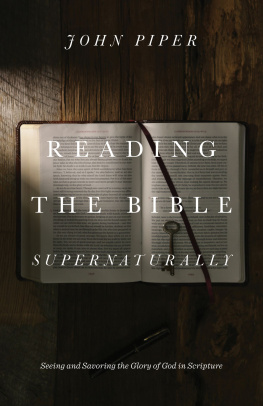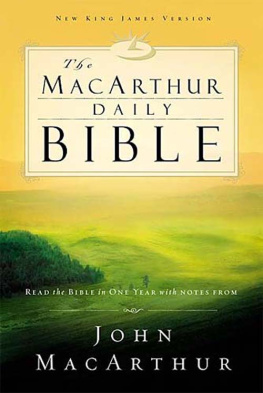Goldingay John - Reading Jesuss Bible
Here you can read online Goldingay John - Reading Jesuss Bible full text of the book (entire story) in english for free. Download pdf and epub, get meaning, cover and reviews about this ebook. publisher: William B. Eerdmans Publishing Company, genre: Religion. Description of the work, (preface) as well as reviews are available. Best literature library LitArk.com created for fans of good reading and offers a wide selection of genres:
Romance novel
Science fiction
Adventure
Detective
Science
History
Home and family
Prose
Art
Politics
Computer
Non-fiction
Religion
Business
Children
Humor
Choose a favorite category and find really read worthwhile books. Enjoy immersion in the world of imagination, feel the emotions of the characters or learn something new for yourself, make an fascinating discovery.
- Book:Reading Jesuss Bible
- Author:
- Publisher:William B. Eerdmans Publishing Company
- Genre:
- Rating:5 / 5
- Favourites:Add to favourites
- Your mark:
- 100
- 1
- 2
- 3
- 4
- 5
Reading Jesuss Bible: summary, description and annotation
We offer to read an annotation, description, summary or preface (depends on what the author of the book "Reading Jesuss Bible" wrote himself). If you haven't found the necessary information about the book — write in the comments, we will try to find it.
Reading Jesuss Bible — read online for free the complete book (whole text) full work
Below is the text of the book, divided by pages. System saving the place of the last page read, allows you to conveniently read the book "Reading Jesuss Bible" online for free, without having to search again every time where you left off. Put a bookmark, and you can go to the page where you finished reading at any time.
Font size:
Interval:
Bookmark:

Reading Jesuss Bible
How the New Testament Helps Us Understand the Old Testament
John Goldingay
WILLIAM B. EERDMANS PUBLISHING COMPANY
GRAND RAPIDS, MICHIGAN
Wm. B. Eerdmans Publishing Co.
2140 Oak Industrial Drive NE, Grand Rapids, Michigan 49505
www.eerdmans.com
2017 John Goldingay
All rights reserved
Published 2017
23 22 21 20 19 18 171 2 3 4 5 6 7
ISBN 978-0-8028-7364-4
eISBN 978-1-4674-4692-1
Library of Congress Cataloging-in-Publication Data
Names: Goldingay, John, author.
Title: Reading Jesuss Bible : how the New Testament helps us understand the Old Testament / John Goldingay.
Description: Grand Rapids : Eerdmans Publishing Co., 2017. | Includes bibliographical references and index.
Identifiers: LCCN 2016054246 | ISBN 9780802873644 (pbk. : alk. paper)
Subjects: LCSH: Bible. New TestamentRelation to the Old Testament. | Bible. New TestamentCriticism, interpretation, etc.
Classification: LCC BS2387 .G54 2017 | DDC 220.6dc23
LC record available at https://lccn.loc.gov/2016054246
Contents
The seed thoughts for this book lie in an article on The Old Testament and Christian Faith published in Themelios 8.1 (1982): 410; 8.2 (1983): 512; and reprinted in revised form in my Key Questions about Biblical Interpretation: Old Testament Answers (Grand Rapids: Baker, 2011), 21132.
Quotations from the New Testament are from Todays New International Version (TNIV). Translations from the Old Testament are my own and are adapted from a draft translation of The Old Testament for Everyone. Some biblical passages cited in this book have different chapter and/or verse numbers in English Bibles from the ones printed in Hebrew Bibles. All biblical references are to the English chapter and verse, even when citing Hebrew terms. Chapter 6 is adapted from draft material for a book on Old Testament Ethics for Everyone.
I am grateful to Michael Thomson and his editorial committee for pushing me to develop the book in the direction that it takes, and to Thomas A. Bennett and Kathleen Scott Goldingay for their careful reading and comments on a draft.
Christian faith focuses on Jesus, and we learn of him from the New Testament. But when the New Testament writers sought to understand Jesus, they assumed that the Old Testament could play a key role in helping them. My concern in this book is to look at the way they went about this task, in order then to consider a question that is the reverse of theirs: to look at the pointers they suggest for understanding the Old Testament itself. The Gospels teach us how to read the OT, andat the same timethe OT teaches us how to read the Gospels. Or, to put it a little differently, we learn to read the OT by reading backwards from the Gospels, andat the same timewe learn how to read the Gospels by reading forwards from the OT.
The term Old Testament does not occur in the New Testament, which obviously also does not refer to itself as the New Testament. Jews call their Scriptures the Torah, the Prophets, and the Writings; the scholarly world today calls them the Hebrew Bible (slightly inaccurately, as part of them is in Aramaic). In Jesuss day, the Torah, the Prophets, and the Writings were simply the Scriptures,could gain quite an adequate understanding of God, of Gods purpose, of Gods ways with us, and of a relationship with God. But they also knew that God still needed to do something spectacular in order to sort the world out and fulfill his own purpose and sort out things for the people of God. That spectacular thing is what Jesus came to do.
In light of his coming, in due course the church developed a collection of written materials telling of what God had indeed done in him and of its implications, to set alongside those existent Scriptures. The church knew that Jesus came to inaugurate a new covenant and that he did so by dying for us; so this covenant was a kind of testament or will. Thus the collection came to be known as the New Testament, and by analogy Christians came to call the existent collection of Scriptures by a new name, the Old Testament. The expression Old Testament is thus anachronistic in connection with the time of Jesus or Paul. For them, these works were simply the Scriptures. In Western cultures, at least, the phrase Old Testament is also something of a slight; it rather implies that this collection of writings is antique and outdated by the New Testament. So from now on, I shall refer to that first collection as the First Testament.
So what significance attaches to the First Testament after Jesus has come? How does the New Testament refer to these writings? What pointers does it give to our interaction with them? The New Testament books vary in how much they refer to those earlier Scriptures and in the way they use them. As it happens, however, the opening pages of the New Testament offer an instructive set of concrete illustrations of what the First Testament signifies for the New Testament. The New Testament thus begins with the First Testament. It opens its account of Jesus by relating him to the First Testament and by explaining who he is by looking at him in light of the First Testament.
Actually, most of the New Testament operates that way to one degree or another. Acts does so. Paul does so, especially in Romans. Hebrews does so. Revelation does so. But the opening chapters of Matthew happen to operate that way in a particularly systematic fashion. I do not imagine that Matthew was consciously aiming to achieve this end, but whether he was trying or not, it is what he succeeded in doing. So a convenient approach to considering our question is to start from Matthews approach; we can then also look at insights from other parts of the New Testament alongside Matthew. Thus in this book I use Matthews five ways of reading the First Testament to frame how we might read the First Testament for ourselves:
- The First Testament tells the story of which Jesus is the climax. Matthew begins here (Matt 1:117) with a kind of summary of the First Testament story up to Jesus in the form of a list of his ancestors. The summary tells us something important about how to understand Jesus and directs us back to the First Testament story in order to expand on that understanding.
- The First Testament declares the promise of which Jesus is the fulfillment. After the list of names, Matthew goes on to tell the story of Jesuss birth and early months (Matt 1:182:23). It shows how passages from the Prophets are fulfilled or filled out in what happens; it thus uses the Prophets to help us understand Jesus and directs us back to read the Prophets.
- The First Testament provides the images, ideas, and words with which to understand Jesus. Matthews account of Jesuss ministry begins with his baptism by John and with Gods words to him from heaven, which come from the First Testament (Matt 3:117). So the account invites us to go back to the First Testament for an understanding of who Jesuss God is.
- The First Testament lays out the nature of a relationship with God. Jesus models the nature of such a relationship during his temptations in the wilderness and teaches about it in the opening section of the Sermon on the Mount (Matt 4:111; 5:116). The first passage quotes extensively from the First Testament, and the second alludes extensively to its motifs, so that it invites us to discover more about the nature of a relationship with God by studying it.
- The First Testament provides the foundation for Jesuss moral teaching. Jesus goes on to declare, You have heard that it was said.... But I tell you... (Matt 5:1748). He is again fulfilling or filling out the First Testament, speaking like a prophet, helping people to see implications in the Scriptures that they might be avoiding, and inviting us to study what the Scriptures have to teach us about the way we should live.
Font size:
Interval:
Bookmark:
Similar books «Reading Jesuss Bible»
Look at similar books to Reading Jesuss Bible. We have selected literature similar in name and meaning in the hope of providing readers with more options to find new, interesting, not yet read works.
Discussion, reviews of the book Reading Jesuss Bible and just readers' own opinions. Leave your comments, write what you think about the work, its meaning or the main characters. Specify what exactly you liked and what you didn't like, and why you think so.

